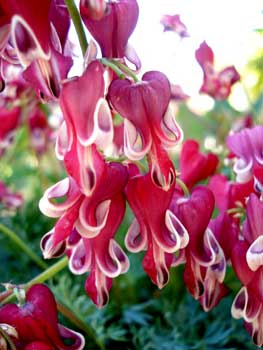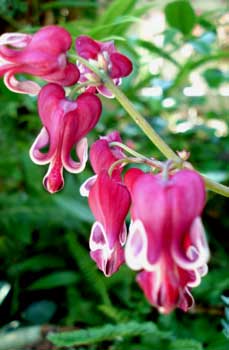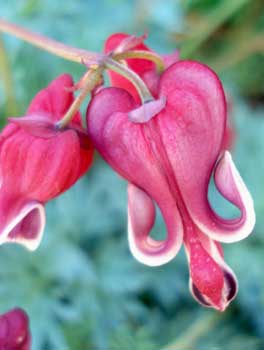
'Burning Hearts'
Dwarf Fern-leaf Bleeding Heart
"Here I will sit upon this naked stone,
Draw my coat closer with my numbed hands,
And hear the ferns sigh, & the wet woods moan,
And send my heart out to the ashen lands."
-Archibald Lampman
(1861-1899)
(1861-1899)
 All over the top of the tightly compact ferny blue-grey foliage of Dicentra x 'Burning Hearts,' the cherry-red heart-shaped flowers are numerous. Each bloom is outlined in ivory-white for further outstanding appearance.
All over the top of the tightly compact ferny blue-grey foliage of Dicentra x 'Burning Hearts,' the cherry-red heart-shaped flowers are numerous. Each bloom is outlined in ivory-white for further outstanding appearance.This introduction for 2009 is my favorite new dicentra cultivar since 'King of Hearts,' & is much redder & more reliably long-blooming than 'King of Hearts.' It blooms in Spring & persists, given good moist soil, right through summer & into autumn.
It's species is almost never cited, though its primary parents appear to be the Japanese bleeding heart D. peregrina with its intensely blue-grey foliage & the western bleading heart D. formosa, though like 'King of Hearts' with the same well-defined white lips, it likely also has a dash of eastern bleeding heart D. eximia in its heritage.
 It was bred in chilly Hokkaido, Japan, by Akira Shiozaki & contracted to Skagit Gardens in Washington state for distribution in America. Shiozaki has developed several marvelous bleeding heart cultivars, but 'Burning Hearts' may well be the height of his achievement.
It was bred in chilly Hokkaido, Japan, by Akira Shiozaki & contracted to Skagit Gardens in Washington state for distribution in America. Shiozaki has developed several marvelous bleeding heart cultivars, but 'Burning Hearts' may well be the height of his achievement.'Burning Hearts' blooms best in bright shade, from mid-April to October. In shade it is surprisingly heat-hardy for a bleeding heart, & our two clumps made it through our record-breaking summer heat (one day it was 105 degrees F. in our garden -- horrifyingly hot by Puget Sound standards) without wilted foliage or loss of bloom. I was careful to keep its spot in the shade-garden moist, & had given it fairly rich very well loosened soil, & when first planted it had a fertilizer boost to get it started.
Though not exactly drought-hardy, it will survive droughtiness by going dormant in summer, with a second flourish of growth in autumn before winter die-back. But if kept well watered it won't die back in summer. At the same time, however, it also dislikes staying wet too long at a stretch, so soil should be moisture-retentive but never actually soggy, or it'll be done in by root-rot or attract mildew.
Even the hardiest dicentra cultivars begin to fade after a few years if the soil becomes compacted & begins to drain poorly. In a couple of years it might be desirable to undertake spring division to get more plants anyway, so use any such opportunity to once again loosen & enrich a broad area of soil for re-planting.